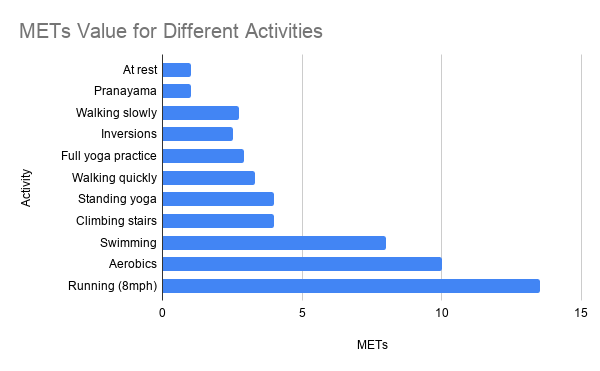What’s This Research About?
The American College of Sports Medicine (ACSM) exercise guidelines recommend 30 minutes of moderate intensity exercise five times a week to decrease disease risk and maintain good cardiovascular health. In 2012, twenty million people were choosing yoga as their form of exercise. It is estimated that by 2020 there will be over 55 million people practicing yoga.
Unlike exercise practices such as running, biking, or walking, there is a lack of information on the metabolic cost of yoga. If health professionals know the energy expenditure (EE) of yoga, they can more accurately assess how much yoga counts towards the allotted exercise to reap the health benefits outlined by the ACSM.
In light of this, the researcher had two goals, first she wanted to review articles that assessed the energy cost of specific asanas, and or different full yoga practices. Secondly she wanted to evaluate the quality of the indirect calorimetry techniques used.

TITLE: A Systematic Review of the Energy Cost and Metabolic Intensity of Yoga
PUBLICATION: Medicine and Science and Sports and Exercise
DATE: 2016
AUTHORS : Evette Larson-Meyer, D. Enette
Indirect Calorimetry: A respiratory test that measures the carbon dioxide production and oxygen consumption using masks or whole respiratory chambers. For accurate measurements it is advised to hold a steady state of the measured activity for at least two to four minutes.
METS (metabolic equivalents): MET is a ratio measurement of energy expenditure relative to a person’s mass. One MET is defined as the oxygen consumed while sitting at rest. The standard used was measured on a 70kg male and is equal to 3.5 ml O2/kg/min. This value is dependent on body mass composition and in the literature has found to often be an overestimation. (1)
MET Exercise Intensity Levels and Equivalent Heart Rates (HR): (2)
| Exercise Intensity Level | METs and Equivalent Heart Rates (HR) | Heart Rates (HR) |
| Light intensity | 2-2.9 METS | 57-63% Max HR |
| Moderate intensity | 3-5.9 METS | 64-76% Max HR |
| Vigorous intensity | 6-8.7 METs | 77-95% Max HR |
- Byrne, N, Hills, A, Hunter, G, Weinsier, R, Schutz, Y, Metabolic Equivalent: One Size Does Not Fit All. J Appl. Physiology. 2005; 99, 1112-1119.
- Hagins M, Moore W, Rundle A. Does practicing hatha yoga satisfy recommendations for intensity of physical activity which improves and maintains health and cardiovascular fitness? BMC Complement Altern Med. 2007;7:40.

